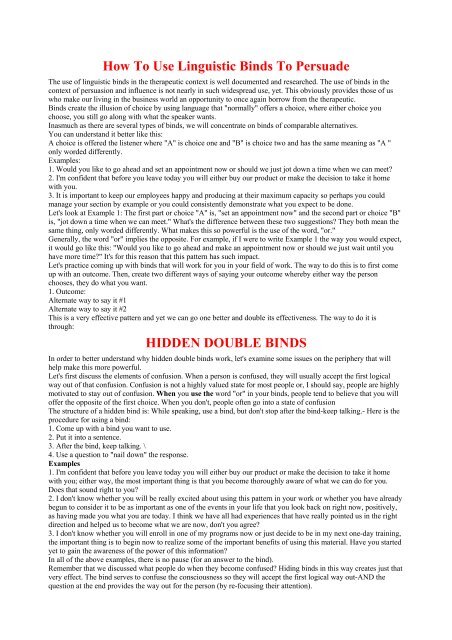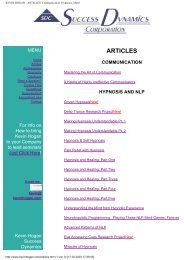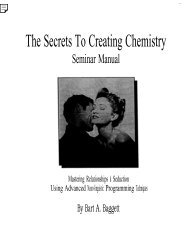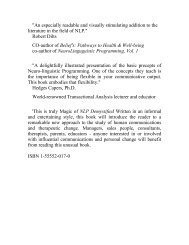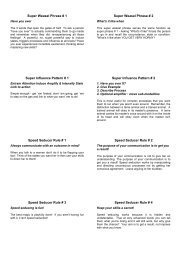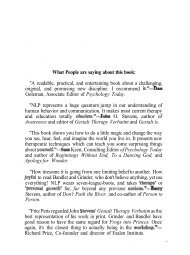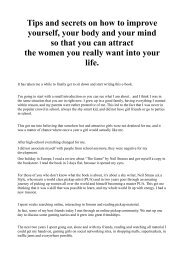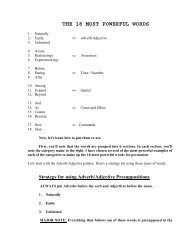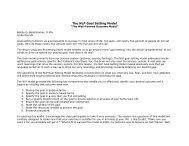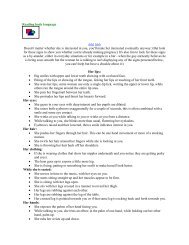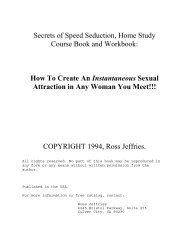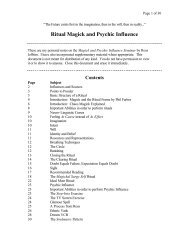How To Use Linguistic Binds To Persuade.pdf - NLP Info Centre
How To Use Linguistic Binds To Persuade.pdf - NLP Info Centre
How To Use Linguistic Binds To Persuade.pdf - NLP Info Centre
Create successful ePaper yourself
Turn your PDF publications into a flip-book with our unique Google optimized e-Paper software.
<strong>How</strong> <strong>To</strong> <strong>Use</strong> <strong>Linguistic</strong> <strong>Binds</strong> <strong>To</strong> <strong>Persuade</strong>The use of linguistic binds in the therapeutic context is well documented and researched. The use of binds in thecontext of persuasion and influence is not nearly in such widespread use, yet. This obviously provides those of uswho make our living in the business world an opportunity to once again borrow from the therapeutic.<strong>Binds</strong> create the illusion of choice by using language that "normally" offers a choice, where either choice youchoose, you still go along with what the speaker wants.Inasmuch as there are several types of binds, we will concentrate on binds of comparable alternatives.You can understand it better like this:A choice is offered the listener where "A" is choice one and "B" is choice two and has the same meaning as "A "only worded differently.Examples:1. Would you like to go ahead and set an appointment now or should we just jot down a time when we can meet?2. I'm confident that before you leave today you will either buy our product or make the decision to take it homewith you.3. It is important to keep our employees happy and producing at their maximum capacity so perhaps you couldmanage your section by example or you could consistently demonstrate what you expect to be done.Let's look at Example 1: The first part or choice "A" is, "set an appointment now" and the second part or choice "B"is, "jot down a time when we can meet." What's the difference between these two suggestions? They both mean thesame thing, only worded differently. What makes this so powerful is the use of the word, "or."Generally, the word "or" implies the opposite. For example, if I were to write Example 1 the way you would expect,it would go like this: "Would you like to go ahead and make an appointment now or should we just wait until youhave more time?" It's for this reason that this pattern has such impact.Let's practice coming up with binds that will work for you in your field of work. The way to do this is to first comeup with an outcome. Then, create two different ways of saying your outcome whereby either way the personchooses, they do what you want.1. Outcome:Alternate way to say it #1Alternate way to say it #2This is a very effective pattern and yet we can go one better and double its effectiveness. The way to do it isthrough:HIDDEN DOUBLE BINDSIn order to better understand why hidden double binds work, let's examine some issues on the periphery that willhelp make this more powerful.Let's first discuss the elements of confusion. When a person is confused, they will usually accept the first logicalway out of that confusion. Confusion is not a highly valued state for most people or, I should say, people are highlymotivated to stay out of confusion. When you use the word "or" in your binds, people tend to believe that you willoffer the opposite of the first choice. When you don't, people often go into a state of confusionThe structure of a hidden bind is: While speaking, use a bind, but don't stop after the bind-keep talking.- Here is theprocedure for using a bind:1. Come up with a bind you want to use.2. Put it into a sentence.3. After the bind, keep talking. \4. <strong>Use</strong> a question to "nail down" the response.Examples1. I'm confident that before you leave today you will either buy our product or make the decision to take it homewith you; either way, the most important thing is that you become thoroughly aware of what we can do for you.Does that sound right to you?2. I don't know whether you will be really excited about using this pattern in your work or whether you have alreadybegun to consider it to be as important as one of the events in your life that you look back on right now, positively,as having made you what you are today. I think we have all had experiences that have really pointed us in the rightdirection and helped us to become what we are now, don't you agree?3. I don't know whether you will enroll in one of my programs now or just decide to be in my next one-day training,the important thing is to begin now to realize some of the important benefits of using this material. Have you startedyet to gain the awareness of the power of this information?In all of the above examples, there is no pause (for an answer to the bind).Remember that we discussed what people do when they become confused? Hiding binds in this way creates just thatvery effect. The bind serves to confuse the consciousness so they will accept the first logical way out-AND thequestion at the end provides the way out for the person (by re-focusing their attention).
<strong>To</strong> experience this effect, have someone read one of the above sentences to you and pay attention to the re-focusingyou experience when the question is asked at the end. The question at the end also causes the bind to go straight intothe person's unconscious as a suggestion. They never need answer it because its purpose is to act as a suggestion.The question at the end also tends to create amnesia for the bind, so the person may never even know that you usedone. In fact, it is my experience that rarely, if ever, does someone realize that a bind was used.Because of the power of this technique, it is especially important to remember to use it in an ethical way that isconsiderate of the needs of the person to whom you are speaking.Whether you incorporate this into your behavior or really enjoy using this to increase your skills while combiningthis with all the other patterns you are surely, by now, using from reading this column, pay attention to how muchmore confidence you are experiencing as a result of having these additional tools. You are reading this columnfaithfully, aren't you?© 1997 Kenrick E. ClevelandSentence FragmentsA Study in Language Skills For Sales, Hypnosis and PersuasionSentence fragments could be defined as incomplete sentences, where the "fragment" is designed to accomplish aspecific mental or behavioral goal.In this Special Report, I'll cover the construction and uses of sentence fragments in a number of differentenviornments.Careful study and practice of these techniques will amplify your abilities in hypnosis and persuasion giving yousuggestion power beyond what was previously thought possible.Let me first outline some of the theory behind the use of this pattern. Dr. Milton H. Erickson pioneered in the use ofindirect, permissive types of suggestion. This type of suggestion could be seen as the opposite of the long popular"direct, authoritarian" types of suggestion.Here's an example of both types of suggestion: The direct authoritarian suggestion - Go into a trance now! Thepermissive style - You may find yourself going into a trance as I speak OR as you think about my words in whateverway helps to facilitate you being able to alter your state of consciousness.While quite a battle needlessly rages on about which method is superior, with practise and training it's my belief thatyou'll discover the followintg:1. Both methods work.2. You should choose the method that appeals to the person you are hypnotising or influencing. (Refer to both myHome Study course and my Advanced Hypnosis Home Study Videos for specific methods of making this choice).3. The use of the indirect permissive method is able to be done very covertly with, for example, no need for a pretalk,should this be desirable as in the case of influencing someone indirectly who is not a client. Sales, would be agood example of this.The use of the permissive, indirect approach is an elegant "natural" way to communicate that shows respect whileeliminating resistance, as well as providing powerful linguistic enviornments to create your persuasive message. Dr.Erickson himself, in his prime, used both methods interspersed with extreme effectiveness. Thus your facility withboth methods is necessitated if you want the flexibility to persuade and hypnotise at high levels.In my opinion, sentence fragments can dramatically add to a hypnotists ability to use "patter" effectively and can beused at any time in the course of "normal speaking" to deliver suggestions more powerfully.They work for a number of reasons. I'm sure, by now, that you are aware of the 7+/- 2 rule that states that yourconscious mind has 7+/- 2 slots of information that it can deal with at any given point in time (Bandler and Grinderparaphrased). The power of these then. . . at one level. . .disarmingly simple. . . is the filling. . . and what does theconscious mind do. . . when filled?. . .So, sentence fragments do fill the conscious minds limited ability to hold a number of separate things for consciousevaluation. What does happen when the conscious mind is overloaded? Think about it right now yourself. As if itwere happening to you now. . . the overloading. . . so much to think about. . . the ease of not having to do anything. .. the comfort of slipping into agreement with me now. . . and staying there. . . in this comfortable state. . . when youthink of these things. . . in the future, now. . .This filling of the conscious mind is also facilitated by your conscious minds need to "fill in the blanks" so to speak.As an example, the last two sentence fragments in the paragraph above could be analized as follows: when you thinkof these things (which things do you mean and when am I to think of them). . . in the future, now (when in the futureand in the future I'm to do what and does now mean to do it now as well or is it possibly the beginning of the nextsentence or both?)...Now just imagine if you were to add some of the 18 Most Powerful Words to this pattern. (If you don't know whatthese words are, refer to my home study course.)Already I hear some of you saying that this sounds great for hypnosis, but sounds much to wordy for persuasionapplications. I will get into that in just a moment - be sure, but first, how about a demonstration of these skills for atrance induction.
You'd like that you say? Well here goes. . .As you read the induction, pay attention to how the sentence fragments assist in the induction process. Read theelipses (. . .)with a good healthy pause. Reading it outloud may help you to "get the feel" for how it works.A Relatively Formal InductionAs you sit there. . . listening to what I'm saying the things that will assist you to . . . enter a relaxed trancecomfortably. . . with your eyes closed. . . you can begin. . . or start in any way that you want. . . thinking of severalthings. . . the second of which. . . can really mesmerize. . . and remembering. . . like you did as a child. . . thoselearning experiences. . . maybe 6 or 7. . . maybe in the first grade. . . back then. . . those little chairs. . . the numbersand letters. . .around the room. . . up on the wall. . . and already. . . you're altering. . . and. . . your unconscious. . .mind. . . can really learn. . . learning the difference between. . . a big O and a big Q. . . and whether. . . 6 was anupside 9. . . or. . . 9 was an upside down 6. . . and you learned how to turn those letters. . . into words. . . thoughts. . .complete ideas. . . deeper and deeper ideas. . . ideas that occupy all of you. . . as if. . . time. . . stands still. . . and aperson could ask of yourself. . . is the body on this chair. . . pressing down comfortably. . . or is the chair pressing upagainst. . . supporting. . . ever so gently. . . yet securely. . . you begin. . . to orient. . . your mind. . . to begin to think.. . really think about. . . what you want to. . . change. . . now. . . you might start. . . to. . . create the change you want.. .And so on you could go. . .One of the best ways I've found to practise this skill, is to talk outloud and at length, using sentence fragments likethe above. You'll find yourself developing a rhythm. And that's exactly what you want to do. In my earlier years(man, it's really hard, even now for me not to write in fragments, or to try and mark off my words with apostrophies,to show the rhythm, that's in my mind - ha ha) I used to do group inductions with an old, loud metronome setbetween 45 and 60 beats per minute. Usually about 60 to start with and then as the trance progressed, I'd slow it to45 beats per minute. <strong>To</strong> bring the group out of trance, I'd just start talking faster and without the rhythm.Now, as you might have guessed, you can't really talk like the above for covert influence applications.For covert applications, you need to make really sure that you have strong rapport. (A technique I teach called"backtracking" helps with this) And you need the ability to just. . . slip into sentence fragments. . . and perhaps. . .use commands. . . or other favorite techniques. . . like I teach in my Home Study course. This ability to just slip intothe fragment way of speaking really opens up a rich enviornment linguistically in which you can put your embeddeddirectives, binds, causal language patterns, 18 most powerful words etc. <strong>To</strong> great use.The idea is to "talk normally" and to just slip a few "highly loaded" sentence fragments in that are designed to getyou what you want - and then immediately transition back to "normal talking". As you do this, make sure and keep astraight face as it can be kind of humerous to slip in a "power packed" fragment or two and the person just looks atyou like as if you are talking normal.One of my favorite ways to use fragments is for the purpose of creating disassociation. Genreally, when a trainedperson here's the word disassociation s/he thinks of conscious/unconscious disassociation. While a bit beyond thescope of this report think of using disassociation in the following ways as well - pain from consciousness -unpleasant experiences from pleasant ones - good decisions from bad ones - anesthesia from hypermnesia.Want an advanced concept to think about? O.K. here it is. Is it possible, to create a conscious/unconsciousdisassociation - anchor it spacially - attach thorugh suggestion and anchoring pleasant decisions to the unconsciousstate and bad decisions to the conscious state? Could you then amplify this by connecting anesthesia to theunconscious state and hypermnesia to the conscious state - thus making bad decisions extremely uncomfortable?Finally, could you link through suggestion etc. what you want the person you are working with/influencing to do tothe unconscious/good decision state and any other decision to the conscious/painful state?Think about it. . .Do you want some practice with conscious/unconscious disassociation?Alrighty then. . .Here's a really good way to practise/learn fragments and conscious/unconscious disassociation patterns. Keep inmind that you can throw "the whole kitchen sink" into these fragments. Such as commands, binds, 18 most powerfulwords, double dissociative conscious/unconscious double binds (fancy huh), causal linkages etc. Let yourimagination run away with yourself.Here's how to do this: Just pick a statement from one side of the page, read it, then pick a causal word from themiddle (if necessary), read it, then pick a statement from the other side of the page. Look them over and give it a try.It'll come real natural for you. Make sure and pause often and appropriately. . . You might also start with or end witha causal word or. . .Mix and Match the Following. . .your unconscious mind isdiligently remembering afavorite time you enteredinto a profound therapeutictrancewhileyour conscious mind recallscreating the change youwant
another part of you. . .decides to create the andyou go deeper into trancewanted results. . .you watch yourselfyou discover these newstillrelaxingchanges are permanentI want to talk with you asyour conscious self isabsorbed elsewhereyou can do many things becauseyour unconscious islearning that carrying outmy ideas and suggestionsmakes you happyAnd on and on you could go. This should spur you to write some of your own examples. Do use them and practisewith them until they become second nature to you. You could even take these and add to them some of your own, ifyou'd like and read them to a client as you are inducing trance (might want them to shut their eyes first).Be creative.© 1997 Kenrick E. Cleveland<strong>How</strong> to <strong>Use</strong> The Language Of Beliefs <strong>To</strong> Increase Your SalesandThe Power Of Your Message.Learn Secret Language Patterns That Make Your Sales Message Irresistable!<strong>Use</strong> Psuedo Logic Patterns Of Cause and Effect Language including Single<strong>Binds</strong> <strong>To</strong> Install Thoughts Into Others.In this article, we will concentrate on cause and effect language. The uses of Cause and effect (CE) language aremany in business.Let's define the term. Cause and Effect is where some person rightly or wrongly ascribes some effect (outcome) to acause (stimulus).If you think about it, all beliefs use cause and Effect to describe what the belief is. An example of this is, "I believethat persuasion skills will cause a sales person to be successful." Let's examine this. The "cause" is persuasion skills,and the effect is success, right? In other words, you could simply say, "persuasion skills cause success." Now, let'sdiscover why this pattern is important in business and how you can use it.Since people use the cause and effect pattern to describe what they believe is true, it can have a very powerfulimpact on people you deal with when you use it in your language. Think for just a moment about something that youbelieve in. In fact write it down. (you may have expressed your belief using only half of the equation such as, " Ibelieve persuasion is good", or "A win - win attitude is necessary. If you did that you have deleted the other half ofyour belief. Therefore to recover it you might ask yourself at the end of what you wrote, because? or, so that? Thiswill uncover the rest of your belief. Using the above example "A win - win attitude is necessary", let's uncover therest. So I say, because? and the answer for me is, "everyone is benefited". Therefore I could state the entire belief as"A win - win attitude is good because everyone is benefited." The cause in that sentence is win - win attitude and theeffect is everyone is benefited. Make sure then that you have written you belief using the above technique so thatboth halves of your belief is stated.)Think about that belief for just a moment now. <strong>How</strong> do you feel when you say it to yourself. If you are like mostpeople you have a sense that, "well of course that's true". <strong>How</strong> would you like to have people thinking that wayabout what you present as you're presenting it? Let me show you the pattern because simply using it will causepeople to begin to believe in what you are saying far more than before you learned to use it. The pattern looks likethis:X Causes YWhat's unique about this is that any X can cause any Y. They do not have to be linked by logic. In fact this is thestructure of logic (or as you have learned above, the structure of beliefs). People attempt to make you believesomething is logical by stating things using this pattern. An example of this is: Reading this column causes you torealize the value that's contained in it for you. What's the X? Reading the column, right? What's the Y? Realizing thevalue, true? Now, I ask you, is there really any connection between reading this column and realizing value? If youbelieve that there is then I have been successful in my use of Cause and Effect. Really, though your mind simplyconnects that some X (reading the column) causes some Y (realizing value for you). Let me give you another one.
Thinking about how you can use this pattern allows you to determine how much more persuasive you'll be as youadopt it into your normal language. Again, do you see how using the pattern makes what's said more persuasive?Here is a list of words that you can use to link the X and Y together.AND, AS, WHILE, DURING, SINCE, CAUSES, FORCES, MAKES, ALLOWS, IMPLIES, PROVOKES,LEADS, BRINGS TO PASS, EFFECTUATES, ENABLES, CONSTITUTES, NECESSITATES.Here's a few more examples. Desiring to increase your persuasion skills enables you to start to use this pattern.Listening to what I say to you today will allow you to come to the understanding that our firm can assist you in theways you need most, right now.Are you beginning to understand how this pattern works? Let me give you an exercise that will help you to perfectyour use of this pattern. I'll list some things that could be considered X's and some things that could be consideredY's and you put them together.X Y1. Sitting there Buy from us2. Thinking about what I say Realize the value in our product3. Listening to your secretary buzz you Go along with our proposal4. Presenting this to your board Enjoy creating this relationship5. Thinking about what you really need Hire meYou can mix and match the above X's and Y's to practice this exercise. Here's just one example. Thinking aboutwhat you really need right now allows you to enjoy creating this relationship with me.Let's move on to another pattern that's similar to the one I just taught you. It's called IMPLIED CAUSE ANDEFFECT. It is represented like this:AS X, YThis pattern simply puts the word that connects the X (cause) and the Y (effect) before the X. This simply implies aconnection rather than forces one. An example: As you read each word in this article, you can become aware of theprofound positive changes taking place right now in your ability to persuade others gracefully. This sentence then,implies a connection between reading and changing.You can use this technique just as you can use the X causes Y technique. The major difference between the two isthat the implied cause and effectis a bit softer. Some people prefer to start off by using the implied cause and effectand then moving on to straight cause and effect.Try going back now to the exercise above and make each one an implied cause and effect sentence.In order to get the most from this information, it is important that you create several outcomes for yourself and thenpractice saying them in the cause effect format so that you can become comfortable in using them.Let's go to the last pattern for this article. It is called Single <strong>Binds</strong>. Single binds are in the cause and effect family.They are especially powerful and fun to use. (critics and cynics, please see paragraph #2.)The structure for Single binds is:The more you X, the more you will YIn this pattern X will represent the trigger for the Y or X can also represent what you don't want to have happen andY can then represent what will happen anyway. You can learn this best by reading a couple of examples. The moreyou try to disagree with me, the more you will find yourself in agreement. <strong>How</strong> do you like it so far? In this sentencethe X is "try to disagree" and the Y is "find yourself in agreement". Get it?Here is another example: The more you understand this pattern, the more you will be compelled to learn even moreabout it. This sentence reinforced a particular behavior, where the one above stopped or changed a particularbehavior.Here's another one: The more you consider doing business with our competitors, the better doing business with usbecomes. Now, let me ask you, is this a useful sentence in the business world?The one thing I often hear in my trainings is, "can you really use this pattern just like that"? The answer isABSOLUTELY YES! You'll get the hang of them the more you practice with them. Of course I could say, the moreyou wonder wither or not you can actually use this pattern the more you will find it naturally coming out of yourmouth. <strong>How</strong>ever, you'll find that they are extremely useful and very powerful in persuading other people.Coming up in other articles we will cover the use of double binds, covert verbal pacing and leading, presuppositionsincluding some little known types of presuppositions and additional language patterns that will help you in businessand persuasion.© 1977 Kenrick E. ClevelandPacing and Leading:A Horse-Sense Approach to Using Persuasion in Sales and Marketing!Tired of trying to convince skeptical prospects to try your products or services? Is there a way to make what you sayfar more believable?Can you go so far as to make what you say automatically accepted?Yes! Absolutely.
It has to do with the way you organize your language-the order in which you say things. And, of course, what youchoose to say.It's simple and effective. And with just a bit of attention and practice, you will find people agreeing with your everyword.There are many different methods taught about bringing a prospect to final agreement. The most common is oneoffered by almost every sales training program around-the 'yes set'.The theory behind the 'yes set' is that if you elicit enough 'yeses' during your conversation, your prospect willautomatically say 'yes' when you ask for the order or other action.Here's an example of the 'yes set' as taught in "traditional" sales classes.Salesman: "Mr. Smith?"Prospect (Mr. Smith): "Yes."Salesman: "Mr. John Smith?"Prospect: "Yes."Salesman: "Thank you. Mr. Smith, my records indicate that you are the vice-president of purchasing. Is that right?"Prospect: "Yes."Salesman: "Great. May I ask you a question?"Prospect: "Yes."Salesman: "If I can show you a way to save costs on your inventory, you would be interested in taking a look,wouldn't you?"And on and on in that manner-both boring and obvious! Yuck!Do you see the pattern there? What happened for you as you read this or were subjected to it? If you're like me, youwere somewhat insulted. You immediately recognized the ploy. You stopped listening and gave your full attentionto devising a way to escape!So, what is the answer? <strong>How</strong> can you get people to say 'yes' without using out-moded tactics such as this?It's simple. Learn to use verbal pacing and leading.Verbal pacing and leading is effective because it automatically sets up an 'unconscious yes set.' And unlike theabove example, you can use this in your written marketing materials as well.Before we investigate just what an 'unconscious yes set' is, let's get clear on some terms:Conscious:What you are aware of in yourself and your surroundings. What you are paying attention to right now. This includesyour thoughts as you read this or prepare to make a presentation, or your awareness of the look on your prospect'sface as you talk.Unconscious:What you are not aware of and not paying attention to right now. An example of this might be the feel of yourclothes on your body, the speed of your breathing, or the amount of light available for you to read this.Unconscious also refers to that which happens automatically. If you are driving down the street and a child runs outin front of you, how long do you have to consider stopping? Probably not long. In fact, your foot seems to hit thebrake without any conscious thought or decision on your part!So, the definition of the unconscious includes both that which you are not aware of and that which happensautomatically.Yes set:As mentioned earlier, a yes set usually refers to a set of questions designed to draw a "yes" response from yourprospect. When your prospect says enough yeses during the presentation, she becomes conditioned to agree withyou. And when you ask her for the order, she will say "yes".Verbal pacing and leading:A sophisticated method of associating things that are true with things that you'd like people to believe are true. Atechnique that enables you to eliminate disagreement and get others to agree with you as a natural consequence oflistening to what you are saying.Pacing:Talking about things that can be immediately proven to be true or things that are commonly accepted as true.Leading:Talking about things that you want the other person to believe that have not as yet been proven true or may not becommonly accepted as true.Some examples of statements that would qualify as pacing are:1. Doctor visits are increasing by leaps and bounds in America! There is more heart disease and obesity than everbefore.2. The nutritional value of our food has been decreasing dramatically over the years.3. Our air, food and water contain many kinds of toxins and poisons.4. Most people would love to feel better, to have more energy.5. You must understand the problem before you can find an effective solution.6. We are all made up of protons, electron, neutrons.
Now list some of your own pacing items. Remember, these should be things that your prospect has consciousawareness of and are generally seen as true. You may even wish to mention specific articles that recently appearedon the news or in the paper in your prospect's area.Leads are anything that you want people to believe. Here are some examples of statements that could be consideredleads:1. What we have been doing isn't working. Using commonly available vitamins and minerals isn't enough.2. If nutritionists and doctors really understood the problem, the population would be getting healthier instead ofexperiencing an increase in disease.3. The answer to our problem lies in providing the appropriate electrical matrices to our bodies.4. There are products that provide these appropriate electrical matrices.5. You will experience a strong positive benefit to your health by using our products.What are some of your own leads? What might you want your prospect to believe as true?Do you begin to see the difference between pacing and leading? Pacing statements are those that are obviously true.You just can't take exception to them! That's what makes them so powerful.Leading statements are not necessarily proven or may not yet be commonly recognized as true, but they are whatyou want your prospect to believe.Now let's look at our elevator speech:"You know how your body's just made of molecules, atoms, electrons? Soyou're ALL electrical. And we show you how to use state-of-the-art electrical nutrition to get an energy explosion!"Pace- "You know how your body's just made of molecules, atoms, electrons?"Pace- "So you're ALL electrical."Lead- "And we show you how to use state-of-the-art electrical nutrition to get an energy explosion!"Try reading just the lead statement alone. Leave the "And" off and start with "we". I'll bet you've tried approaching aprospect with an introductory statement that addresses the end result you want. (such as, "are you ready to buy if youget the right price" etc.) <strong>To</strong>ugh sell, wasn't it?Now precede the lead with the paces-which is the obvious fact that everyone's body is made of molecules, atoms andelectrons. After all, we learned that in 7th grade science class. Common knowledge.Then the next pace-that we are all electrical. It follows logically from the first pace.After the paces, the lead just seems to grow naturally out of them. Powerful, isn't itEach time you use a pace, your prospect's unconscious says "yes". Only this is so subtle (albeit powerful) thatnobody thinks of it as an assault. Instead, you create an environment that is comfortable. One that supports the otherperson in moving with you toward your desired end.When you use these techniques, begin with two or three pacing statements followed by a lead. But don't just rattleoff a list of pacing statements or questions. Engage your prospect in a conversation-make it flow easily. Ask forshort responses from your prospect, selecting pacing statements that he or she is almost guaranteed to agree with!Then you may gradually reduce the number of pacing statements before you add a lead. After a while, you can evenfollow a single pacing statement with a number of leads.Pace, pace, pace, lead;Pace, pace, lead, lead;Pace, lead, lead, lead.Now, take just a moment and do this. On a sheet of paper, draw a vertical line down the middle. On the left side, list10 or 15 paces. On the right side, 10 or 15 leads.Practice out loud, saying two or three paces and then a lead. Then a few more paces and a couple of leads. Keepdoing this, with various paces preceding your leads. When done well, this should have a rhythm, with the pacesfollowing logically from the previous lead. As you practice, you will find this becomes almost second nature!Make your leads easy to accept and move your prospect smoothly towards the outcome you want.Next opportunity you have, use pacing and leading. You'll find agreement everywhere you turn!© 1997 Kenrick E. Cleveland


